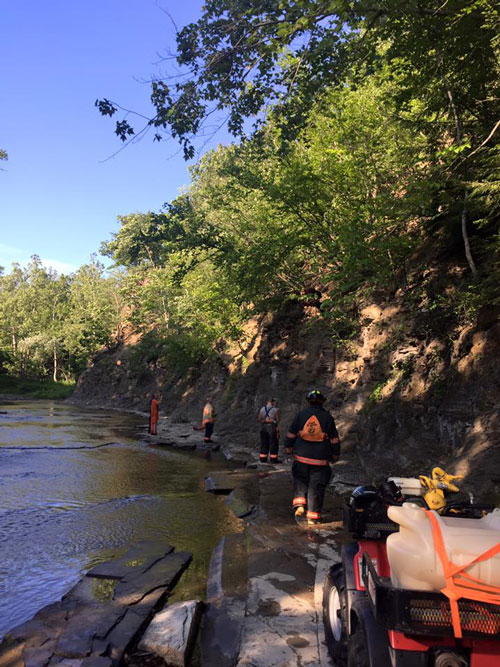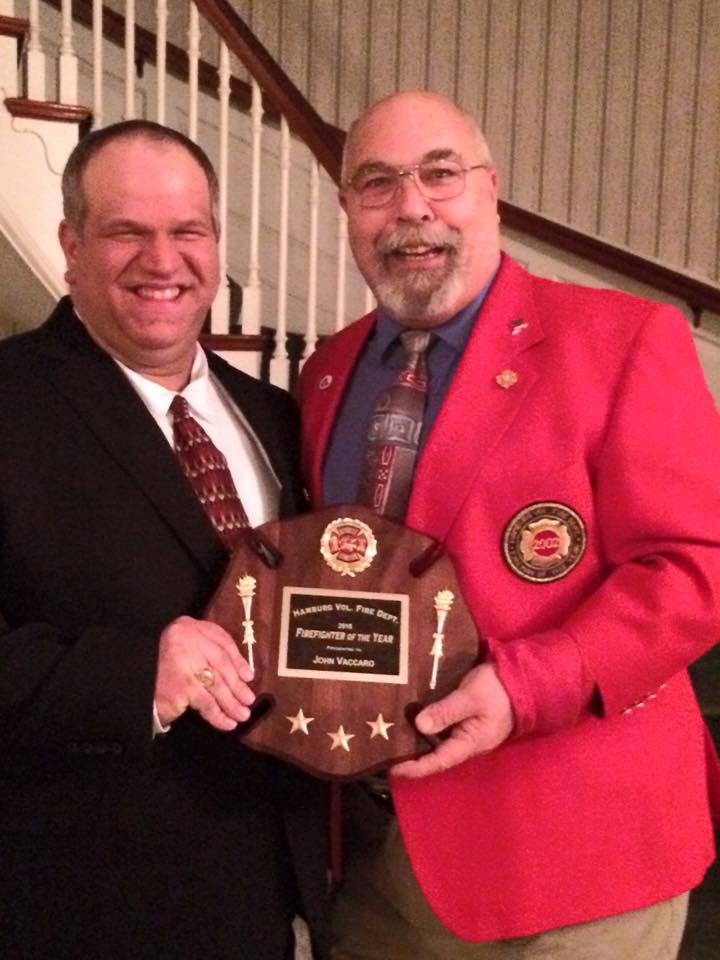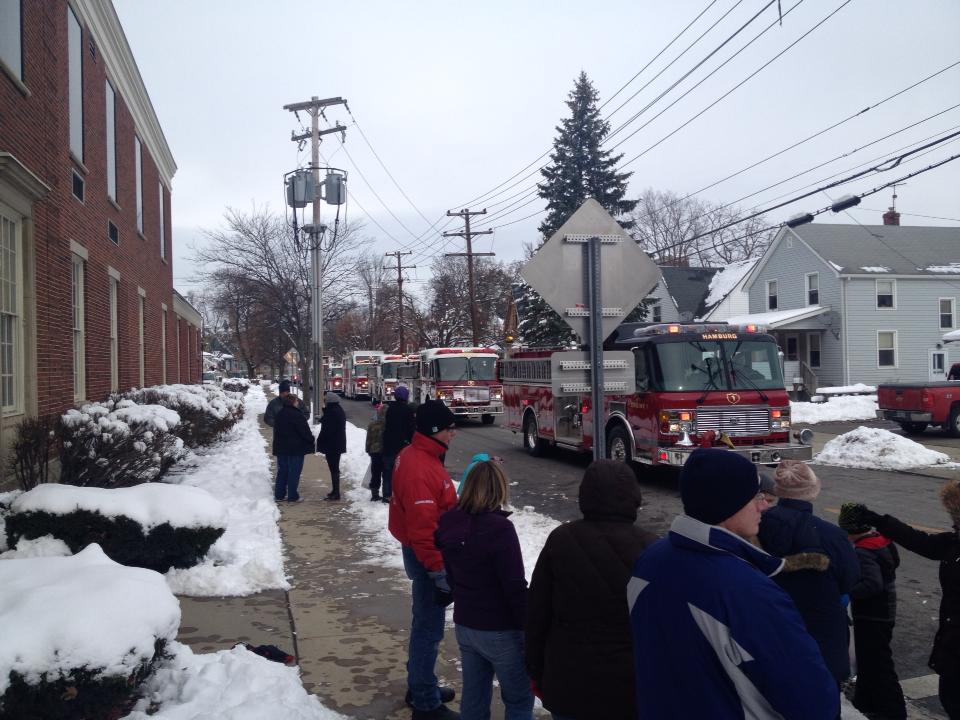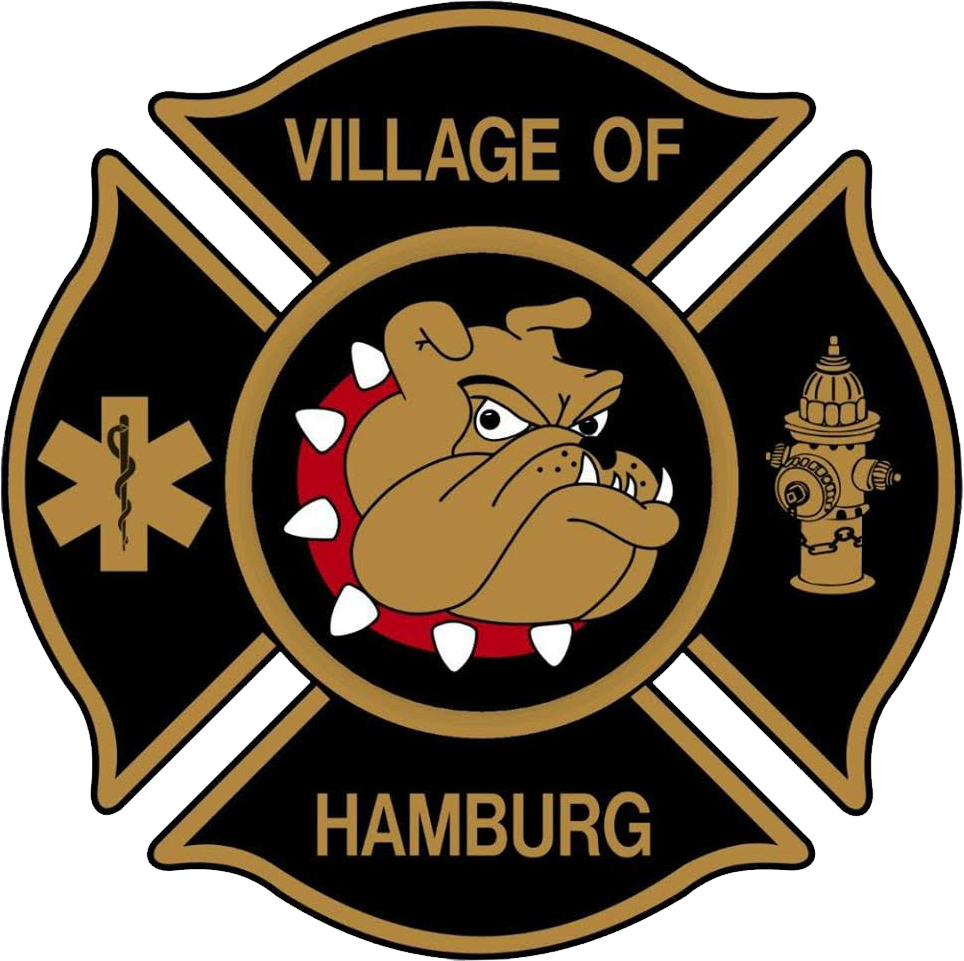
Department History
The Hamburg Volunteer Fire Department celebrated its 100th anniversary in 1980, but its roots go back even earlier. On May 9, 1874, the hamlet which had been known as Whites Corners, was incorporated as the Village of Hamburg. Fire fighting duties at that time were the responsibility of the property owners, and it was pretty much a “bucket brigade” operation. Alex C. Stolting, who founded the “Erie County Independent”, a weekly newspaper that eventually became the “Hamburg Sun”, gathered the local able-bodied men into a Volunteer Fire Brigade to fight fires under more organized conditions. The Village provided them with a hand pumper, which was apparently housed at Mr. Stolting’s place of business. He established himself as Fire Warden, and supposedly slept beside the hand pumper. Stolting, who had lost his right arm as a dock worker in Buffalo, sold the newspaper in 1881, and went on to study law. He was admitted to the bar, and practiced both in Buffalo and in Hamburg, serving Hamburg as Village Justice from 1918 to 1926. Stolting is considered as “Hamburg’s pioneer fireman and founder of the Fire Department”
During the summer of 1878, a group of men, probably many of the original Fire Brigade members, decided to form a fire company. According to a poem written by Mrs. Perry Thorn, whose husband was an early fire fighter and also Village Clerk, this fire company numbered twenty-four men, and they elected a slate of officers with Burwell Abbott listed as President and Dan Prindle listed as Chief.
On May 28, 1878 the Village Board authorized a the purchase of a hand-drawn hook & ladder wagon. On June 24, 1878, a tax excise for the fire apparatus was certified, and on July 13, 1878 a motion was carried to pay the Babcock Manufacturing Company $556.44 for a “hook and ladder aerial truck complete” with additional freight charges from Chicago of $14.47. The hook & ladder truck was housed in the barn of Gelina Hall through 1880 with a rental fee of $12.00, which was paid by the Village. At this same time ( July 1878 ) the Fire Company presented the Village Board with a list of the names of its members, and was to be known as Hook and Ladder Company No. 1, Foreman William Kronenberg, and Hook and Ladder Company No. 2, Foreman George Federspiel. Daniel F. Prindle was listed as Chief Engineer.
In 1879, funds were appropriated to buy a site on Center Street, and later to “construct a house to store the fire apparatus belonging to the Village and for the accommodation of the Fire Department of said Village”. By the year 1880, the Fire Department had accumulated additional apparatus in the form of hose carts and a supply wagon, along with sufficient equipment to function in a proper fashion.
On June 1, 1880 they adopted the “Constitution and By-laws of the Hamburg Hook & Ladder Company No. 1” The combined Hook & Ladder Companies were referred to in Village Board minutes as the Fire Department of the Village of Hamburg. The firemen referred to themselves as the Hamburg Fire Department, as evidenced by the original invitation to “ The First Annual Ball of the Hamburg Fire Department, held at Kopp’s Hall on Thanksgiving eve, November 25, 1880”. It is from this June 1, 1880 date that the present Fire Department celebrated its 100th birthday. In 1883 the Village Board was petitioned by the fire department to empower them to seek articles of incorporation. Authorization was granted and steps were subsequently initiated toward this end.
On August 7, 1885 at a regular meeting of the Hamburg Hook & ladder Company No.1, the Company was virtually disbanded, and a new company called the Hamburg Fire Company was formed, with William Kronenberg named as Chief Engineer. On August 28, 1885 a new slate of officers was elected headed by President Charles Wood. Charter membership was limited to twenty-five members. It was further recorded that “another fire company, with D.F. Prindle as Chief Engineer will be organized next week”.
“Articles of Incorporation of Hamburg Fire Company” were recorded in the Erie County Clerk’s Office on March 22, 1886. This document limited the Company’s existence to fifty years. On July 30, 1886 application of the “Hamburg Engine Company” of the Village of Hamburg, listing the same roster as old Hook & Ladder Company No. 1, was received by the Village Board, accepted and “certification was duly granted”. This may have been the company headed by Dan Prindle which was previously mentioned. On September 4, 1886 the Village raised, by assessment, $650 with which to purchase “a fire engine, apparently a hand pumper , suction hose and 200 feet of discharge hose to be used by the Fire Department of said Village”.
It is important to note here that since many of the Fire Department’s early records are not complete, much of its history has been traced through the minutes of the Village Board meetings.
Hose Cart # 1 Memorial Day Parade Buffalo St at Maple Ave
The Fire Department records, such as they are, along with the minutes of what was reported to the Village Board, provide a relatively accurate history, but some information is difficult to obtain. Articles in local period newspapers show some discrepancies. Because early script-handwriting was sometimes difficult to read, along with confusion over the spelling of names and the terminology of officers, it is easy to see why such discrepancies occurred. The terms “Chief” and “Chief Engineer” may have caused old records to list conflicting names as chief of the department at one give time. Village records show Dan Prindle as Chief in 1884, while an article published in the “Erie County Independent” lists Erastus Fogelsanger as Chief in that same year. Later records show William Kronenberg as Chief in 1885, while an article in the “Hamburg Post”, dated May 6, 1936, regarding the Exempt Reunion, acknowledges Charles Wood as the oldest Exempt member in attendance at the age of eight-nine, and the first Chief of the Hamburg Fire Company of 1885.
The Village entered into a contract with the Hamburg Water and Electric Light Company on September 13, 1889 to supply water for the purpose of extinguishing fires. This resulted in a improved water system and fire hydrants. The present Community Center Building on Prospect Avenue originally housed the water company. Water was pumped from huge wells into standpipes to provide adequate main-line pressures. On October 10, 1889 the Village Board made a motions that the Fire Department sell the “little pump and rubber hose accompanying same, to the North Collins Fire Company for $80”. This is presumed to be the hand pumper from the original Fire Brigade.
On December 3, 1890 the Village Board moved to “make such repairs upon the building of Mr. T.S. Bunting as shall make it proper place for storing hose carts, etc.”.
On March 15, 1892 the Board empowered the Fire Department to “build a hose house on the parsonage lot facing Linwood Avenue, cost not to exceed $80”.
Inventory records between 1902 and 1905 show hose cart houses at Main Street ( possibly Bunting’s building ) Lake Street and “Centre” Street. They also list various apparatus and equipment including a hook & ladder truck and a supply wagon. Although records cannot be found to verify its purchase date, photographs show a horse-drawn vehicle described as the “Hamburg Chemical Company” about the turn of the century.
During the time of its reorganization and incorporation, the Fire Department had as many as four hose carts which were housed at various places throughout the Village. The hose house which had been built on Center Street about 1880 became outgrown by 1905 and was demolished. A larger building was constructed with a hose-drying tower and with second floor meeting rooms. This building was eventually replaced by what was known later as Station 3, until the current fire hall on Buffalo Street across from Maple Avenue was built. Old Stations 3 was sold and it now houses a furniture refinishing business on Center Street.
For many years, old Station 1 on South Buffalo Street, which was built in 1908 and dedicated during “Old Home Week” in 1912, housed Hamburg’s Pumper #1, as well as the Village Police Department and jail. This building was replaced by both the fire hall on Long Avenue ( which before June of 1885 was known as Water Street ) and the present Village Hall on Main Street. Old Station 1 on South Buffalo Street is now the Chamber of Commerce Building.
An early member of the Fire Department, Michael J. Schmidt, operated a livery stable on Lake Street, in which he housed a hook & ladder wagon which was purchased in 1905 by the Village for the Fire Department and provided the team of horses to draw it as needed. Schmidt served for a time as Foreman of the Hook & Ladder Company, which is shown in a photograph taken during the celebration in 1912. In 1919 the Village purchased a portion of his property on Lake Street on which to construct a new fire hall.
In the mid 1930’s the Village purchased additional land from Mr. Schmidt in the rear of the fire hall and also made some alterations to the building. In 1943 a storage building was erected in the rear of the Lake Street Fire Hall and it now stores antique fire apparatus and historical memorabilia. The original Lake Street Fire Hall was finally razed and the present building was erected in 1952.
In 1912, the first motorized apparatus was purchased. A Ford Motel T chemical truck which was later sold to the Scranton Fire Company. A bid for $1 was accepted on March 3, 1933.
Ford Model T 1912 Station No. 1
This truck is still in the possession of the Scranton Fire Company and has recently been restored. In 1920 the first American LaFrance pumper was purchased, which was later sold to a mid New York State fire company, who it is believed still maintain it as an antique. In 1925 another pumper was purchased from American LaFrance and designated as Pumper #2. This engine was later sold to the Armor Fire Company. Pumpers were replaced or added over the years at approximately twenty year intervals and today the Village of Hamburg Fire Department boasts four Class-A , 1500 gallons-per-minute pumpers.
On July 21-25, 1912 the Hamburg Fire Company hosted the “Fourth Annual Convention of the Southwestern Association Volunteer Firemen of New York”. This occurred during the week of July 21-27, when the Town of Hamburg also celebrated its Centennial which was know as “Old Home Week”. Festivities during “Old Home Week” drew an estimated crowd of 25,000 to the lavishly decorated Village. Southwestern Conventions were later held in 1927 and 1947.
An Exempt Firemen Organization was formed in 1912. A large photograph of its members was taken in 1913 in the City of Buffalo. It shows sixty-two exempts and fifty-nine firemen, many of whom have been identified, and an imposing drum major named Bill Witte whose combined height of 6’ 11” along with his high bearskin hat and plume reached nine feet.
Around the year 1925, Hamburg purchased its first motorized aerial ladder truck . It was a homemade affair purchased from the City of Batavia, an originally horse drawn American LaFrance 55 foot aerial ladder mechanism which had been mounted on a Thomas chassis. A photograph shows the vehicle, apparently decorated for a parade in Batavia in April of 1918. Howard Mohr, who later served as department Chief, refitted the aerial mechanism to a 1927 Federal chassis. A two speed differential rear-end was later installed by Barney Machmer. The Federal ladder truck served the department until 1954 and eventually became the pride and joy of such members as Arthur Howe, after whom Howe Field was named. After another twenty years serving the Village Department of Public Works and the Erie County Agricultural Society at the fairgrounds, the truck was restored by George Emerling and Donald Jacobs, assisted at times by other firemen. An interesting note here is that all three motorized ladder trucks that served the department are still on the road and operational. The 1927 Federal is fully restored as an antique and has appeared on numerous occasions and has won a number of awards. The 75 foot aerial ladder truck, purchased in 1954 from American LaFrance was sold to the Bellevue Fire Company of Cheektowaga. It has recently been rebuilt and serves them as a first line ladder truck. The present 100 foot American LaFrance ladder truck was purchased in 1975 and is housed at Station 1 on Long Avenue.
In 1927 the first aid squad was initiated. This squad responded to emergency first-aid calls in the Village and surrounding areas, to provide assistance until an ambulance arrived on the scene. Around 1960 the Lions Club of Hamburg donated a Ford Station Wagon to the fire department for use as an ambulance. Over the years the equipment has ranged from Cadillac limousines to today’s dual wheeled van unit. In 1946, a GMC/Maday unit was purchased to serve as the departments first Emergency Truck which has evolved to today’s custom-built International Heavy Rescue Truck.
Articles of Incorporation were recorded for the Hamburg Volunteer Fire Department in 1936 to replace the expired 1886 incorporation and P.J. Henry Hauck, who served the department for a total of fifty years, was installed as the President for 1937. No record of a President serving from 1901-1936 has been found.
The Hamburg Fire Department also had a fine drum corps, which in 1938 won the New York State Championship at a convention at Saranac Lake and was invited to compete at the World’s Fair to be held the following year Flushing, Long Island. Many residents who have been in the Hamburg for fifty years or more can still remember the thrill of the music of the Hamburg Fire Department Drum Corps parading down the street led by Harold “ Tiny ” Weiss, their giant Drum Major. The Drum Corps eventually evolved into the “Kingsmen” which also went on to great renown. The Kingsmen have now disbanded.
The members of today’s Hamburg Volunteer Fire Department are well aware of the pride and dedication exhibited by their forerunners and though today’s chemicals and plastics have necessitated advances in breathing apparatus, a device which early fire fighters had to do without, their danger was just as real as ours today and we are proud to follow our courageous pioneers. Whether you go back to Stolting or Prindle or Kronenberg or Wood, today’s Hamburg firefighters are grateful to be a part of an organizations with such a long and glorious history.











